The March 2021 Damasi Earthquake Sequence, Central Greece: Reactivation Evidence across the Westward Propagating Tyrnavos Graben
Abstract
1. Introduction
2. Material and Methods
2.1. Mapping of Fault Array and Documentation of Ground Failures
2.2. Liquefaction Features
2.3. SAR Interferometry of the Epicentral Area
3. Coseismic and Cumulative Faulting Evidence
4. Discussion
5. Concluding Remarks
- (1)
- This study demonstrates the presence of a complex continuous fault array characterizing the epicentral area of the Damasi earthquake. In the epicenter, the fault array includes reactivated NNE to NE- or SSW to SW-dipping faults, and N-S trending inherited structures likely play a secondary role in the seismogenesis.
- (2)
- The faults with a morphological expression within the area trend WNW-ESE, and are characterized by linear fault scarps and well-exposed triangular facets, indicating long-term deformation. The Titarissios River sinuosity possibly reflects short term deformation before the recent seismicity.
- (3)
- The documented recent activity of these faults confirms that the Tyrnavos Graben was representing a seismic gap [7] in Central Greece and suggests that the tectonic basin is still growing and propagating westwards. Accordingly, the specific role of the Vlachogianni (VF) and Mesochori (MF) Faults was previously underestimated.
- (4)
- The VF and MF control a minor graben structure that resembles the embryonic stage of the Tyrnavos Graben’s recent westward propagation.
Author Contributions
Funding
Data Availability Statement
Conflicts of Interest
References
- Koukouvelas, I.K. Geology of Greece. In Liberal Books; Athens Publishing: Athens, Greece, 2019; p. 343. [Google Scholar]
- Doutsos, T.; Pe-Piper, G.; Boronkay, K.T.; Koukouvelas, I. Kinematics of the Central Hellenides. Tectonics 1993, 12, 936–953. [Google Scholar] [CrossRef]
- Doutsos, T.; Koukouvelas, I.K.; Xypolias, P. A new orogenic model for the External Hellenides. Geol. Soc. Lond. Spec. Publ. 2006, 260, 507–520. [Google Scholar] [CrossRef]
- Caputo, R. Geological and Structural Study of the Recent and Active Brittle Deformation of the Neogene-Quaternary Basins of Thessaly (Central Greece); Aristotle University of Thessaloniki: Thessaloniki, Greece, 1990. [Google Scholar]
- Doutsos, T. Postalpine geodynamik thessaliens (Griechenland). Z. Dtsch. Geol. Ges. 1980, 131, 685–698. [Google Scholar]
- Caputo, R. Morphotectonics and kinematics along the Tyrnavos Fault, Northern Larissa Plain, Mainland Greece. In Neotectonics and Active Faulting; Stewart, I., Vita-Finzi, C., Owen, L.A., Eds.; G. Borntraeger: Stuttgart, Germany, 1993. [Google Scholar]
- Caputo, R. Inference of a seismic gap from geological data: Thessaly (Central Greece) as a case study. Ann. Geophys. 1995, 38. [Google Scholar] [CrossRef]
- Caputo, R.; Pavlides, S. Late Cainozoic geodynamic evolution of Thessaly and surroundings (central-northern Greece). Tectonophysics 1993, 223, 339–362. [Google Scholar] [CrossRef]
- Caputo, R.; Helly, B. The Holocene activity of the Rodià Fault, Central Greece. J. Geodyn. 2005, 40, 153–169. [Google Scholar] [CrossRef]
- Kokkalas, S.; Xypolias, P.; Koukouvelas, I.; Doutsos, T. Postcollisional contractional and extensional deformation in the Aegean region. In Postcollisional Tectonics and Magmatism in the Mediterranean Region and Asia; Dilek, Y., Pavlides, S., Eds.; Geological Society of America: Boulder, CO, USA, 2006; Volume 409, pp. 97–123. [Google Scholar]
- Tsodoulos, I.M.; Stamoulis, K.; Caputo, R.; Koukouvelas, I.; Chatzipetros, A.; Pavlides, S.; Gallousi, C.; Papachristodoulou, C.; Ioannides, K. Middle-Late Holocene earthquake history of the Gyrtoni Fault, Central Greece: Insight from optically stimulated luminescence (OSL) dating and paleoseismology. Tectonophysics 2016, 687, 14–27. [Google Scholar] [CrossRef]
- Caputo, R.; Bravard, J.-P.; Helly, B. The Pliocene-Quaternary tecto-sedimentary evolution of the Larissa Plain (Eastern Thessaly, Greece). Geodin. Acta 1994, 7, 57–85. [Google Scholar] [CrossRef]
- Caputo, R.; Helly, B.; Rapti, D.; Valkaniotis, S. Late Quaternary hydrographic evolution in Thessaly (Central Greece): The crucial role of the Piniada Valley. Quat. Int. 2021, in press. [Google Scholar] [CrossRef]
- Caputo, R.; Helly, B.; Pavlides, S.; Papadopoulos, G. Palaeoseismological investigation of the Tyrnavos Fault (Thessaly, Central Greece). Tectonophysics 2004, 394, 1–20. [Google Scholar] [CrossRef]
- Caputo, R.; Helly, B. The European palaeoseismological museum of Tyrnavos, Central Greece. Geophys. Res. Abstr. 2007, 9, 283. [Google Scholar]
- Caputo, R.; Piscitelli, S.; Oliveto, A.; Rizzo, E.; Lapenna, V. The use of electrical resistivity tomographies in active tectonics: Examples from the Tyrnavos Basin, Greece. J. Geodyn. 2003, 36, 19–35. [Google Scholar] [CrossRef]
- Caputo, R.; Hinzen, K.-G.; Liberatore, D.; Schreiber, S.; Helly, B.; Tziafalias, A. Quantitative archaeoseismological investigation of the Great Theatre of Larissa, Greece. Bull. Earthq. Eng. 2011, 9, 347–366. [Google Scholar] [CrossRef]
- Caputo, R. The Rodia Fault: An active complex shear zone (Larissa Basin, Central Greece). Bull. Geol. Soc. Greece 1993, 28, 447–456. [Google Scholar]
- Caputo, R. Ground effects of large morphogenic earthquakes. J. Geodyn. 2005, 40, 113–118. [Google Scholar] [CrossRef]
- Papazachos, B.; Papazachou, C. The Earthquakes of Greece, 2nd ed.; Editions ZITI: Athens, Greece, 1997; 304p. [Google Scholar]
- Caputo, R.; Helly, B. Archaeological evidences of past earthquakes: A contribution to the SHA of Thessaly, Central Greece. J. Earthq. Eng. 2005, 9, 199–222. [Google Scholar] [CrossRef]
- Papastamatiou, D.; Mouyaris, N. The earthquake of 30 April 1954, in Sophades (Central Greece). Geophys. J. R. Astron. Soc. 1986, 87, 885–895. [Google Scholar] [CrossRef]
- Papadopoulos, G.A. Rupture zones of strong earthquakes in the Thessalia region, Central Greece. Boll. Geofis. Teor. Appl. 1992, 35, 363–374. [Google Scholar]
- Ambraseys, N.N.; Jackson, J.A. Seismicity and associated strain of central Greece between 1890 and 1988. Geophys. J. Int. 1990, 101, 663–708. [Google Scholar] [CrossRef]
- Papazachos, B.C.; Panagiotopoulos, D.G.; Tsapanos, T.M.; Mountrakis, D.M.; Dimopoulos, G.C. A study of the 1980 summer seismic sequence in the Magnesia region of Central Greece. Geophys. J. R. Astron. Soc. 1983, 75, 155–168. [Google Scholar] [CrossRef]
- Lekkas, E.; Agorastos, K.; Mavroulis, S.; Kranis, C.; Skourtsos, E.; Carydis, P.; Gogou, M.; Katsetsiadou, K.-N.; Papadopoulos, G.; Triantafyllou, I.; et al. The early March 2021 Thessaly Earthquake Sequence. Newsl. Environ. Disaster Crises Manag. Strateg. 2021, 3. [Google Scholar] [CrossRef]
- Ganas, A.; Valkaniotis, S.; Briole, P.; Serpetisdakis, A.; Kapetanidis, V.; Karasante, I.; Kassaras, I.; Papathanassiou, G.; Karamitros, I.; Tsironi, V.; et al. Domino-style earthquakes along normal faults in Northern Thessaly (Greece): Kinematic evidence from field observations, seismology, SAR interferometry and GNSS. Bull. Geol. Soc. Greece 2021, in press. [Google Scholar]
- Nikolakopoulos, K.; Kavoura, K.; Depountis, N.; Kyriou, A.; Argyropoulos, N.; Koukouvelas, I.; Sabatakakis, N. Preliminary results from active landslide monitoring using multidisciplinary surveys. Eur. J. Remote Sens. 2017, 50, 280–299. [Google Scholar] [CrossRef]
- Koukouvelas, I.K.; Nikolakopoulos, K.G.; Zygouri, V.; Kyriou, A. Post-seismic monitoring of cliff mass wasting using an unmanned aerial vehicle and field data at Egremni, Lefkada Island, Greece. Geomorphology 2020, 367, 107306. [Google Scholar] [CrossRef]
- Kyriou, A.; Nikolakopoulos, K.; Koukouvelas, I.K.; Lampropoulou, P. Repeated UAV campaigns, GNSS measurements, GIS, and petrographic analyses for landslide mapping and monitoring. Minerals 2021, 11, 300. [Google Scholar] [CrossRef]
- Massonnet, D.; Rossi, M.; Carmona, C.; Adragna, F.; Peltzer, G.; Feigl, K.; Rabaute, T. The displacement field of the Landers earthquake mapped by radar interferometry. Nature 1993, 364, 138–142. [Google Scholar] [CrossRef]
- Massonnet, D.; Feigl, K.L. Satellite radar interferometric map of the coseismic deformation field of the M D 6.1 Eureka Valley, California earthquake of 17 May 1993. Geophys. Res. Lett. 1995, 22, 1541–1544. [Google Scholar] [CrossRef]
- Peltzer, G.; Rosen, P. Surface displacement of the 17 May 1993 Eureka Valley, California, earthquake observed by SAR interferometry. Science 1995, 268, 1333–1336. [Google Scholar] [CrossRef] [PubMed]
- Meyer, B.; Armijo, R.; de Chabalier, J.B.; Delacourt, C.; Ruegg, J.C.; Acache, J.; Briole, P.; Papanastassiou, D. The 1995 Grevena (northern Greece) earthquake: Fault model constrained with tectonic observations and SAR interferometry. Geophys. Res. Lett. 1996, 23, 2677–2680. [Google Scholar] [CrossRef]
- Wright, T.J.; Parsons, B.E.; Jackson, J.A.; Haynes, M.; Fielding, E.J.; England, P.C.; Clarke, P.J. Source parameters of the 1 October 1995 Dinar (Turkey) earthquake from SAR interferometry and seismic body wave modelling. Earth Planet. Sci. Lett. 1999, 172, 23–37. [Google Scholar] [CrossRef]
- Burgmann, R.; Rosen, P.; Fielding, E. Synthetic aperture radar interferometry to measure Earth’s surface topography and its deformation. Ann. Rev. Earth. Planet. Sci. 2000, 28, 169–209. [Google Scholar] [CrossRef]
- Funning, G.J.; Garcia, A. A systematic study of earthquake detectabilityusing Sentinel-1 interferometric wide-swath data. Geophys. J. Int. 2019, 216, 332–349. [Google Scholar]
- Tolomei, C.; Caputo, R.; Polcari, M.; Famiglietti, N.A.; Maggini, M.; Stramondo, S. The use of interferometric synthetic aperture radar for isolating the contribution of major shocks: The case of the march 2021 Thessaly, Greece, seismic sequence. Geosciences 2021, 11, 191. [Google Scholar] [CrossRef]
- Goldstein, R.M.; Werner, C.L. Radar interferogram phase filtering for geophysical applications. Geophys. Res. Lett. 1998, 25, 4035–4038. [Google Scholar] [CrossRef]
- Antoniadis, P.; Zeppos, I.; Gentzis, T. A preliminary study of the geology of the elassona lignite deposits in Central Greece. Energy Sources 2003, 5, 383–393. [Google Scholar] [CrossRef]
- Pe-Piper, G.; Doutsos, T.; Boronkay, K. Structure, geochemistry and mineralogy of Hercynian granitoid rocks of the Verdikoussa area, Northern Thessaly, Greece and their regional significance. Neues Jahrb. Mineral. Abh. 1993, 165, 267–296. [Google Scholar]
- Wallace, R.E. Geometry and rates of change of fault-generated range fronts, north-central Nevada. J. Res. U.S. Geol. Surv. 1978, 6, 637–650. [Google Scholar]
- Hack, J.T. Stream profile analysis and stream gradient index. J. Res. U.S. Geol. Surv. 1973, 1, 421–429. [Google Scholar]
- The Greece Database of Seismogenic Sources (GreDass). 2013. Available online: http://gredass.unife.it/ (accessed on 25 July 2021).
- Rigo, A.; Chabalier, J.; Meyer, B.; Armijo, R. The 1995 Kozani-Grevena (Northern Greece) earthquake revisited: An improved faulting model from synthetic aperture radar interferometry. Geophys. J. Int. 2004, 157, 727–736. [Google Scholar] [CrossRef]
- Kobayashi, T.; Tobita, M.; Koarai, M.; Okatani, T.; Suzuki, A.; Noguchi, Y.; Yamanaka, M.; Miyahara, B. InSAR-derived crustal deformation and fault models of normal faulting earthquake (Mj 7.0) in the Fukushima-Hamadori area. Earth Planets Space 2012, 64, 15. [Google Scholar] [CrossRef][Green Version]
- Wang, Y.; Lin, Y.N.N.; Simons, M.; Tun, S.T. Shallow rupture of the 2011 Tarlay earthquake (Mw 6.8), Eastern Myanmar. Seismol. Soc. Am. Bull. 2014, 104, 2904–2914. [Google Scholar] [CrossRef]
- Forsyth, D.W. Finite extension and low-angle normal faulting. Geology 1992, 20, 27–30. [Google Scholar] [CrossRef]
- Fernández-Blanco, D.; de Gelder, G.; Lacassin, R.; Armijo, R. Geometry of flexural uplift by continental rifting in corinth, Greece. Tectonics 2020, 39, 5685. [Google Scholar] [CrossRef]
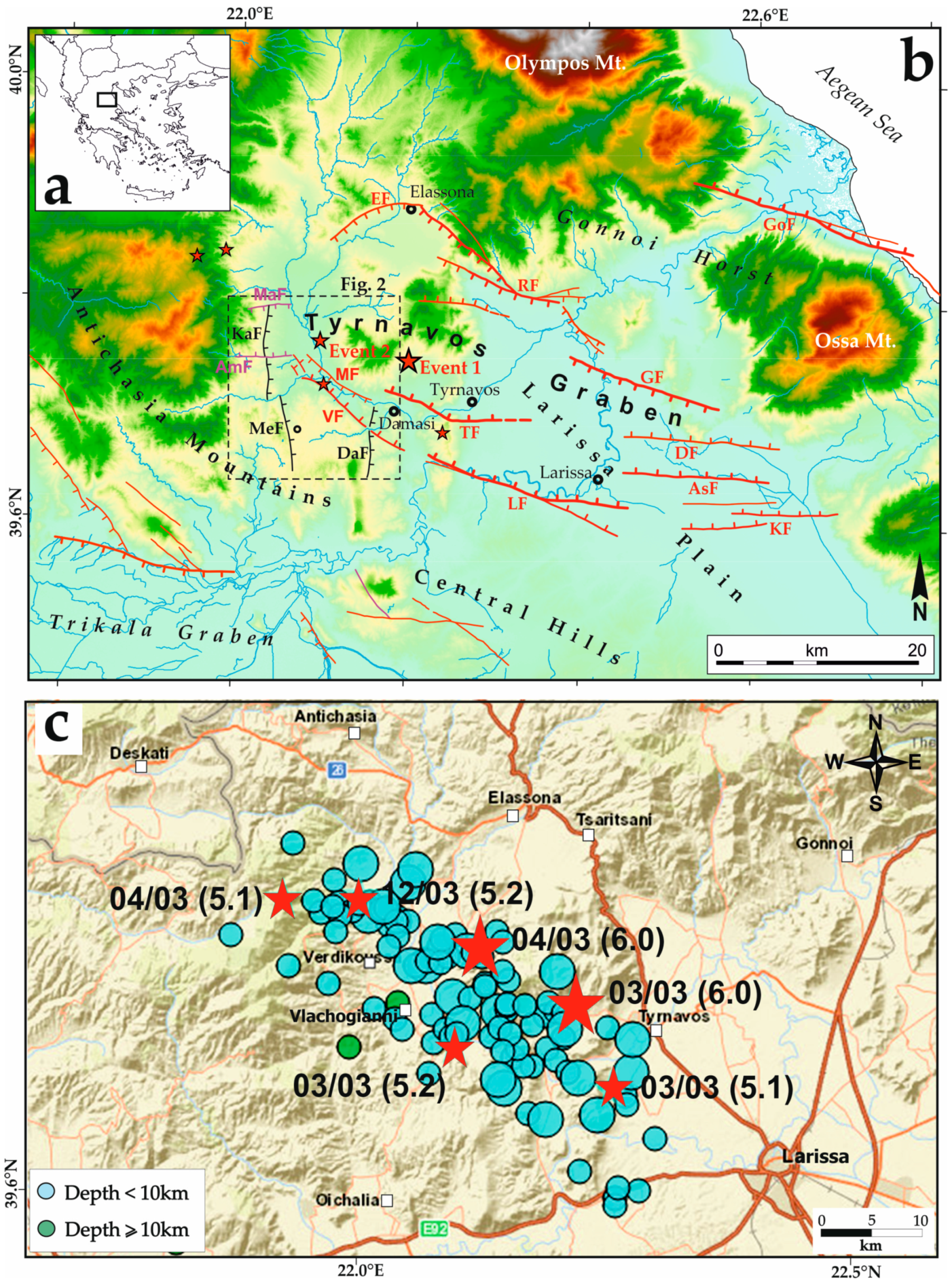
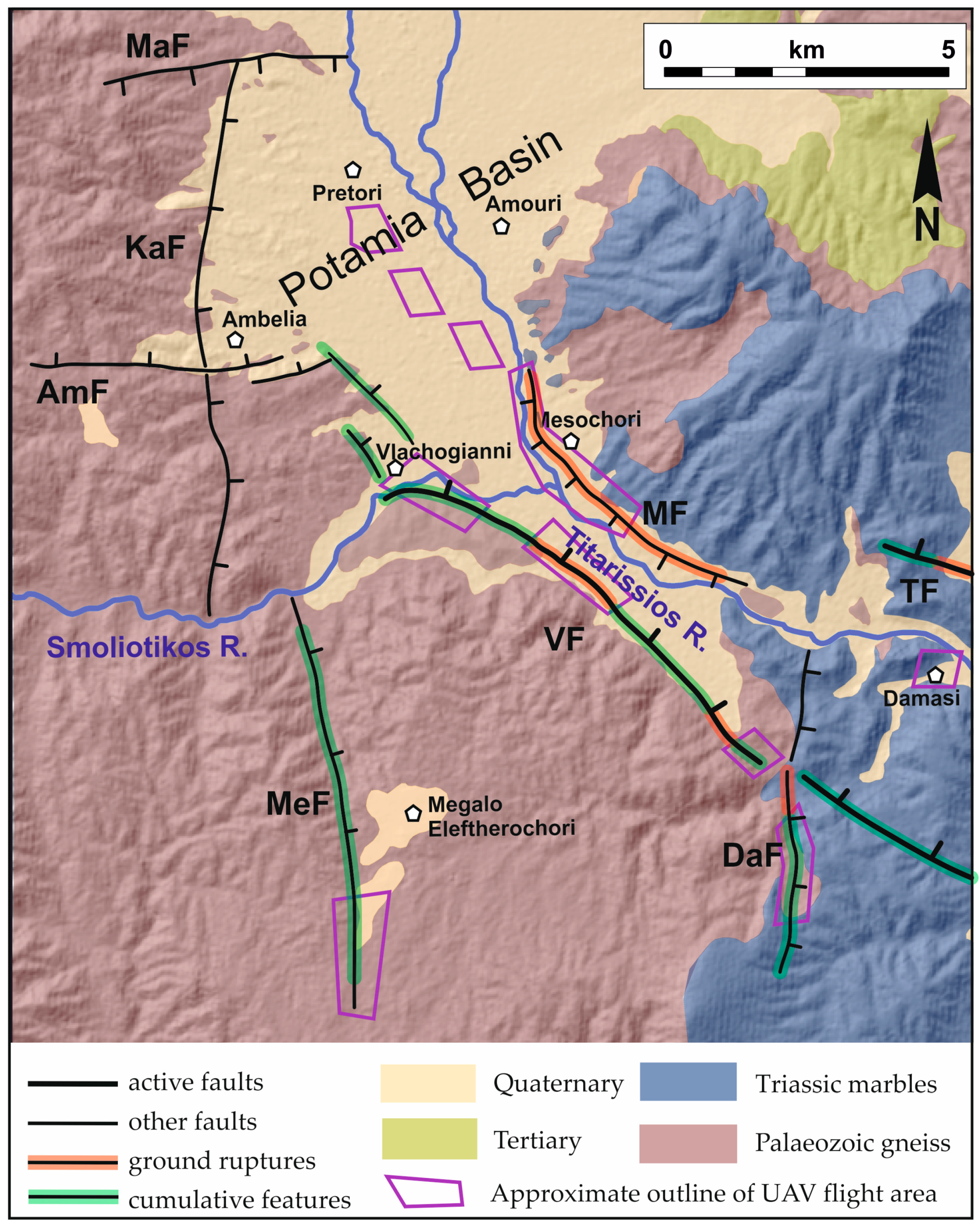
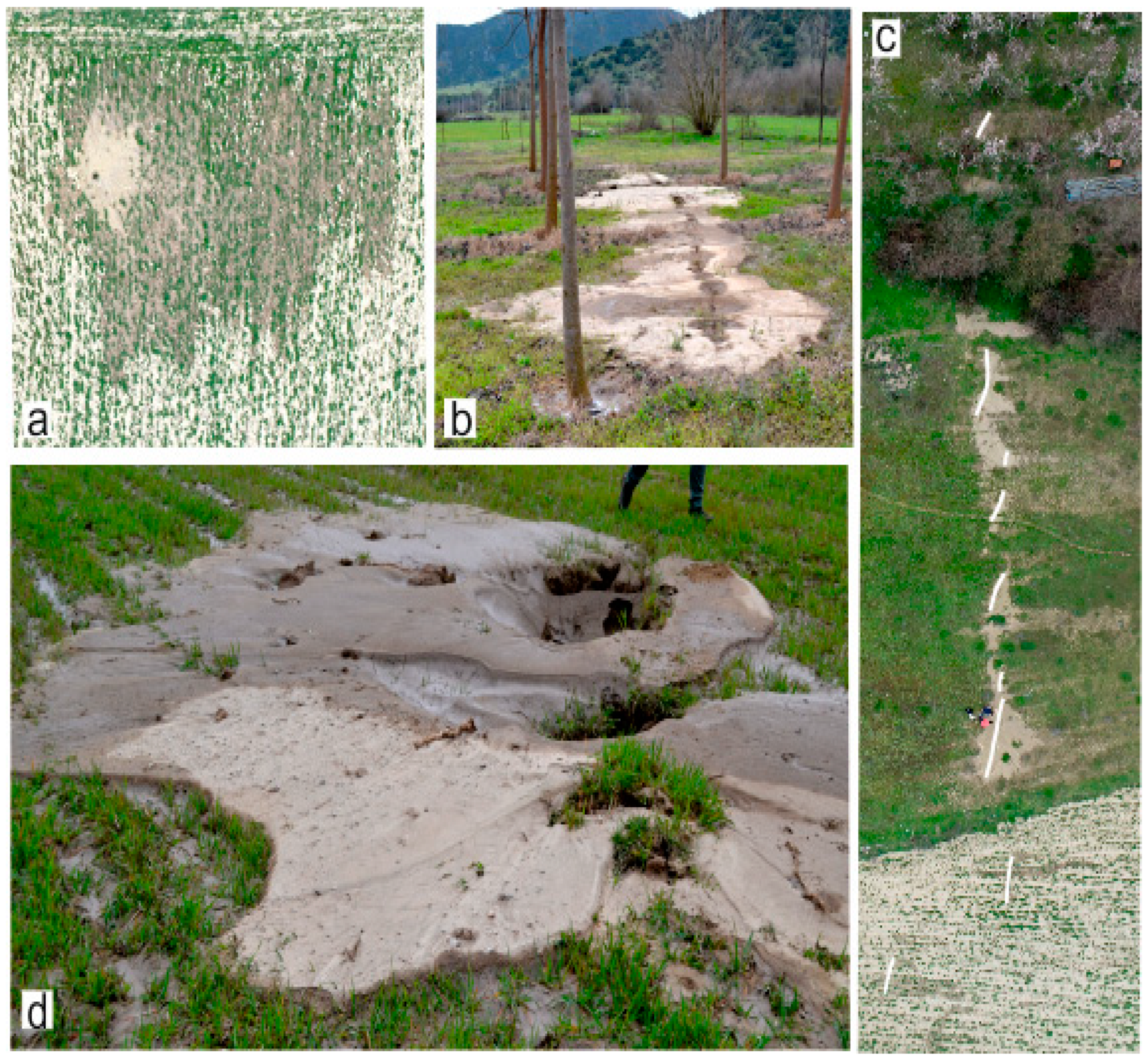
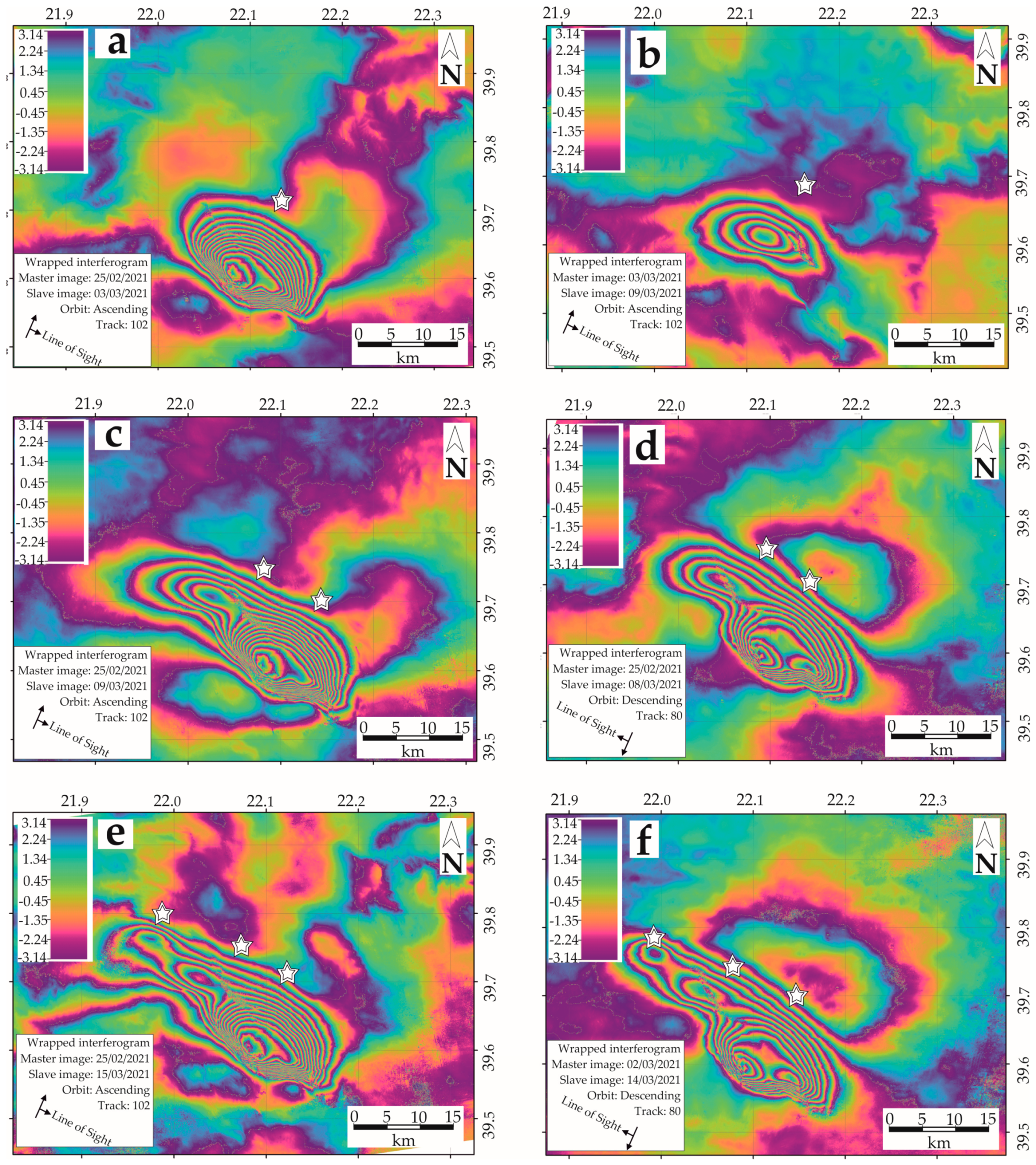

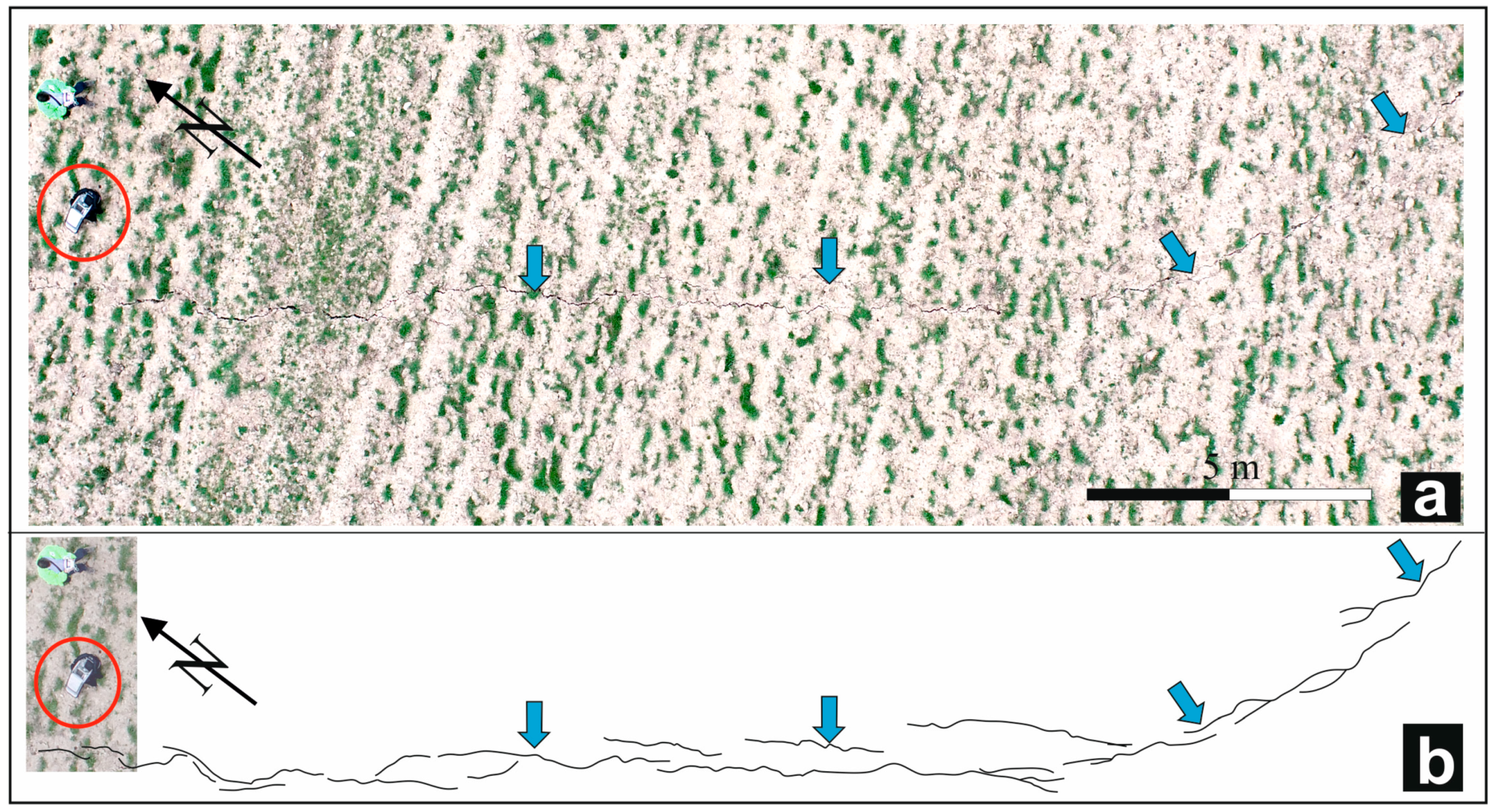
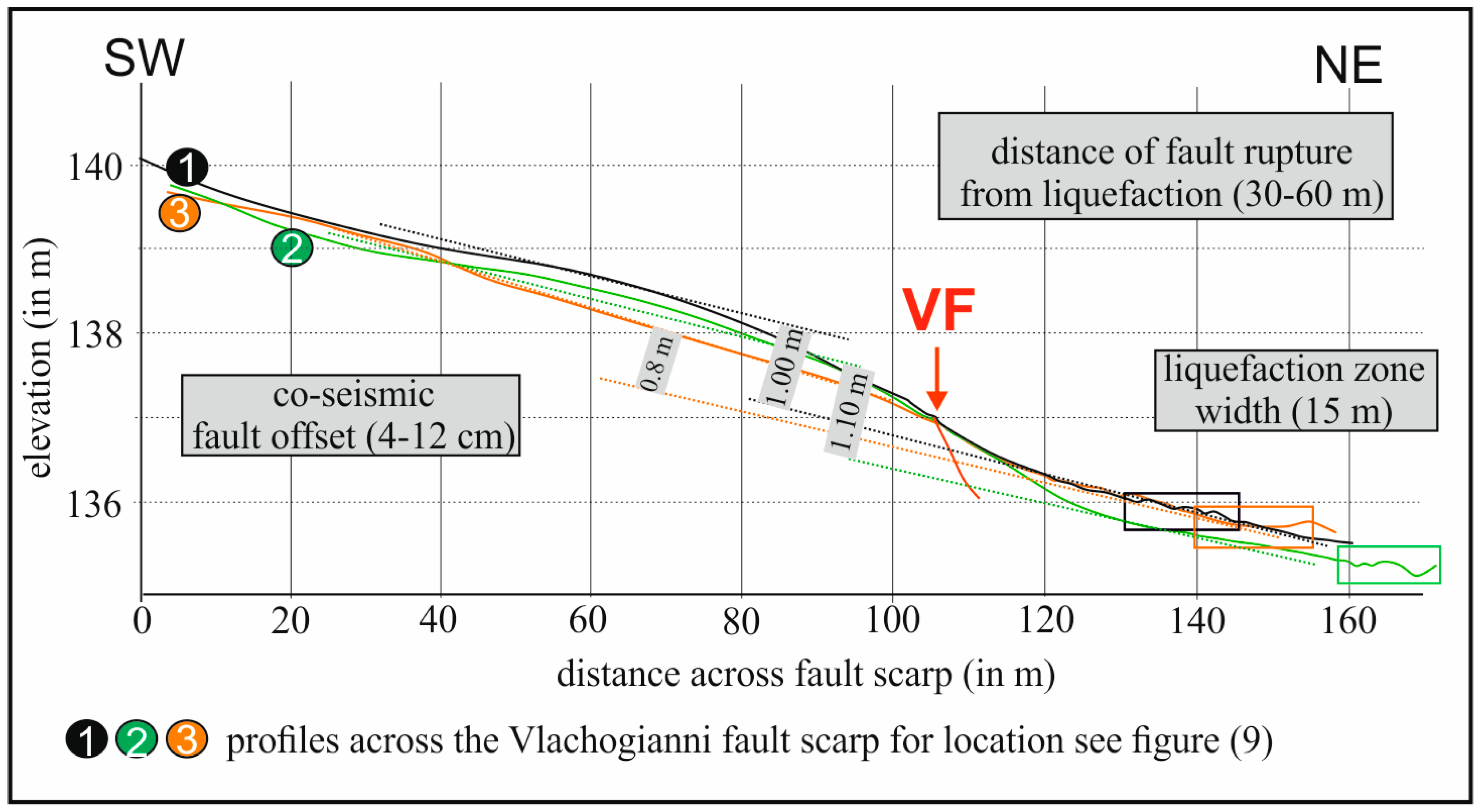
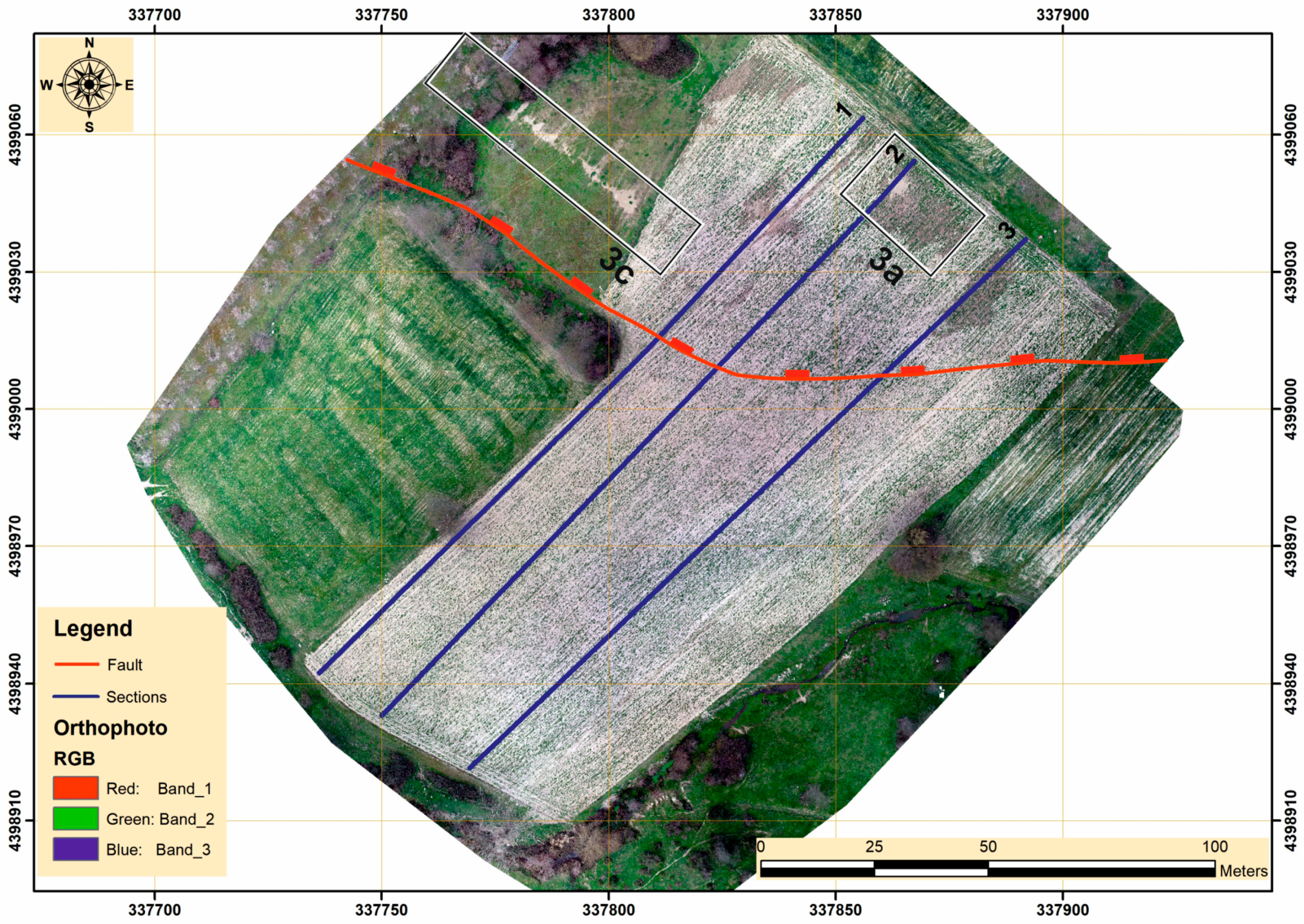
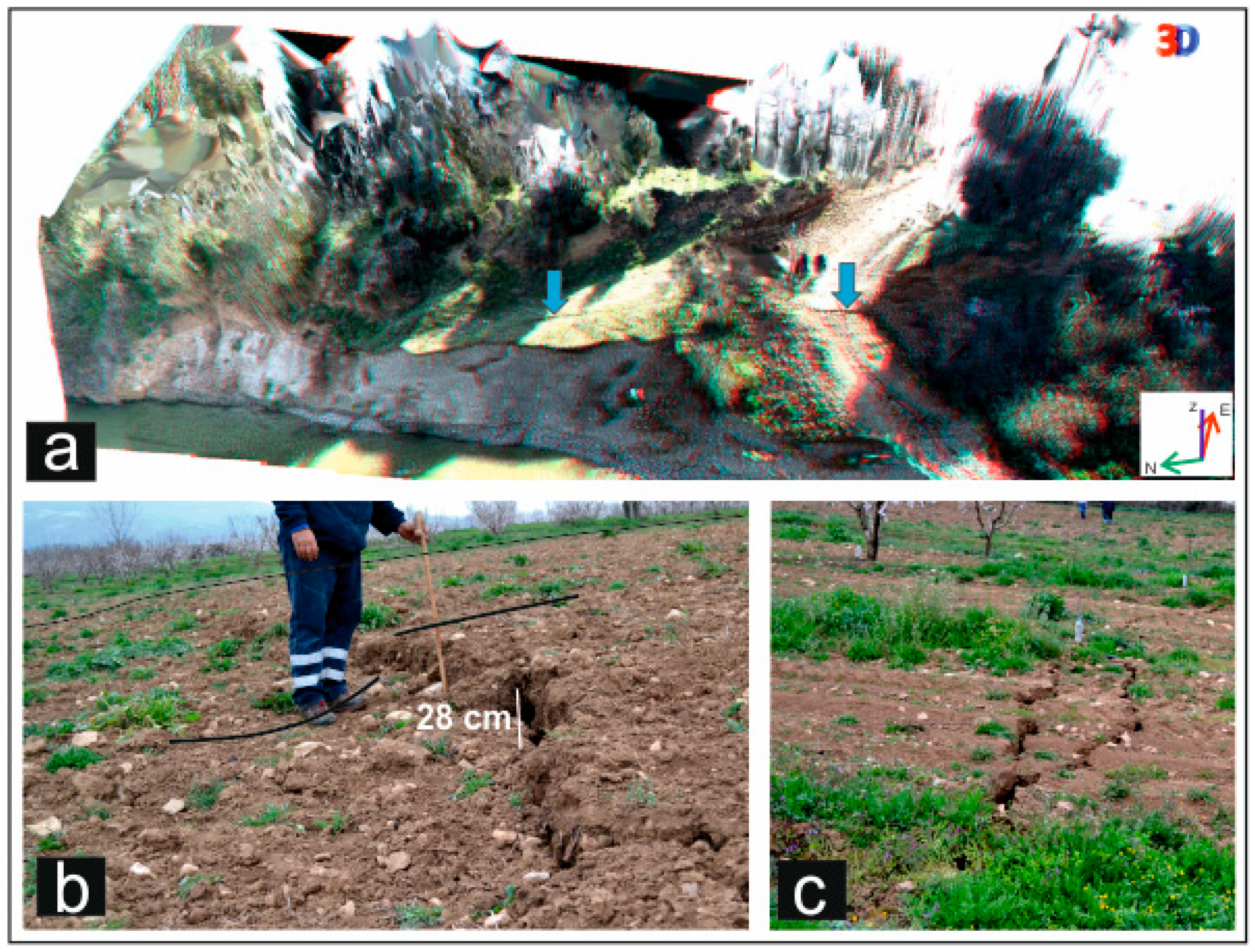
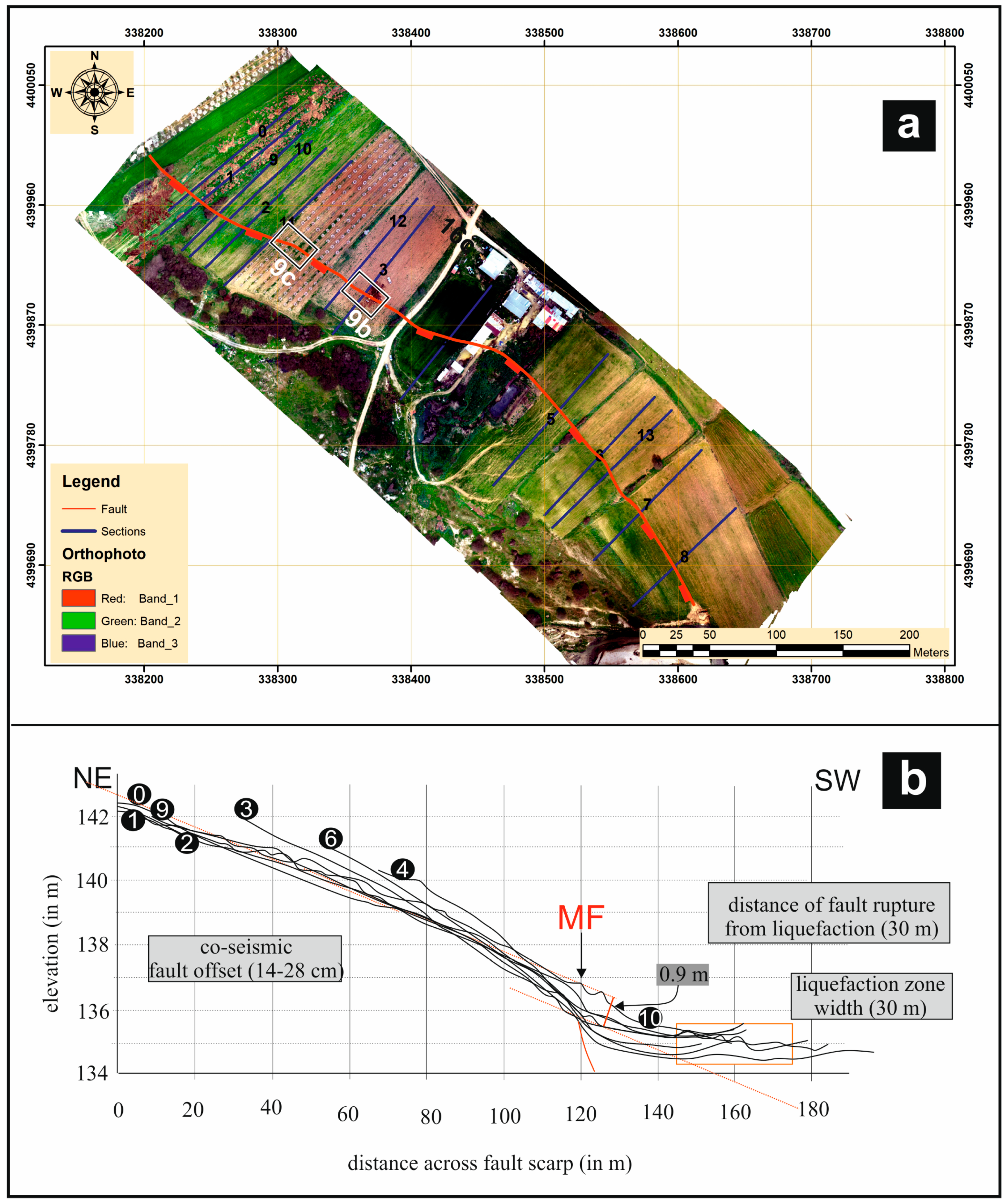

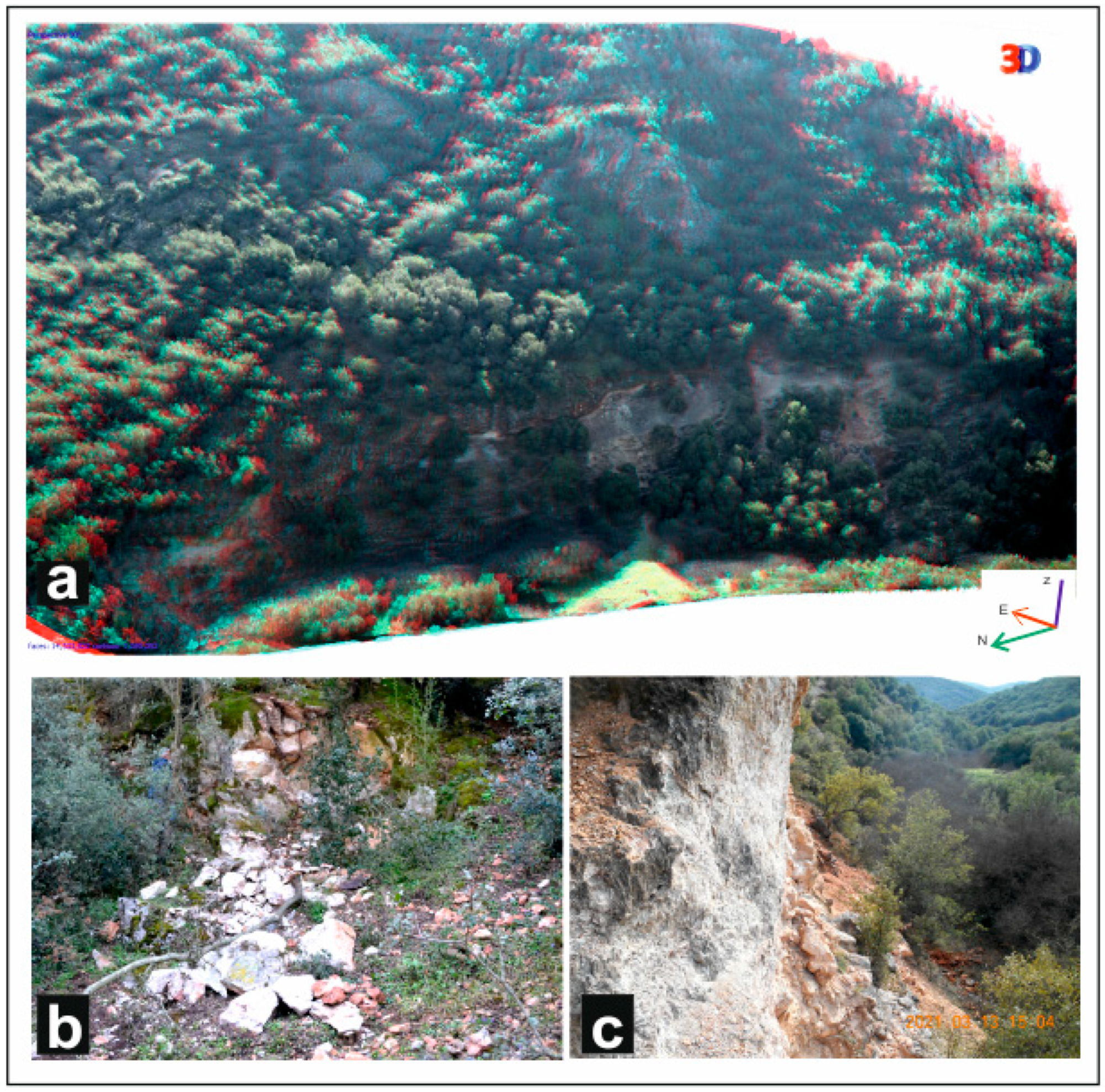

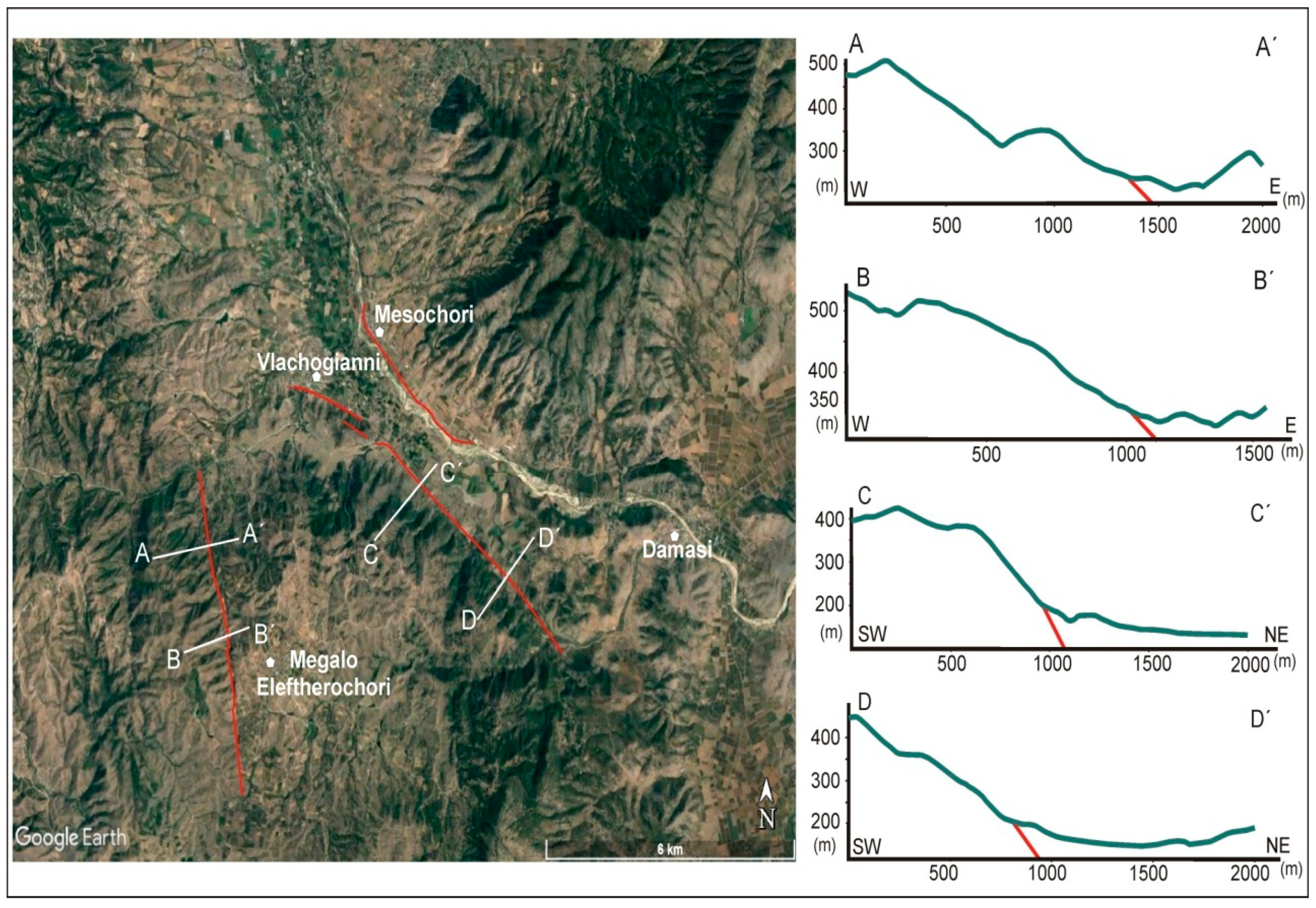


| Earthquakes | Date | Mm | Imax | Epicentre | Sector | ITG |
|---|---|---|---|---|---|---|
| Instrumentally Recorded | 13 May 1995 | 6.6 | IX | Kozani | NW | IV–V |
| 9 July 1980 | 6.4 | VIII | Almyros | S | IV–V | |
| 8 March 1957 | 6.8 | IX | Velestino | S | V(–VI) | |
| 19 April 1955 | 6.2 | VIII | Volos | S | V | |
| 30 April 1954 | 6.7 | IX | Sophades | SW | VI–VII | |
| 1 March 1941 | 6.1 | VII | Larissa | TG | (VIII–)VII | |
| 31 March 1930 | 6.1 | VIII | Pouri | SE | V | |
| 23 February 1930 | 6.0 | VIII | Keramidi | E | V | |
| 22 October 1911 | 6.0 | VIII | Keramidi | E | VI | |
| Historical written sources | Date | Mm | Imax | Epicentre | SectorTG | ITG |
| 20 January 1905 | 6.2 | X? | Skiti | E | VII | |
| 17 November 1901 | 5.0? | VI–VII? | Verdikoussa | NW | ? | |
| 15 May 1900 | 5.0? | VI(–VII) | Sykourio | TG | VI(–VII) | |
| 9 January 1892 | 5.0? | VI(–VII) | Larissa | TG | VI(–VII) | |
| 3 October 1868 | 6.3 | VIII | Skiathos Is. | SE | - | |
| 21 October 1864 | 6.0 | VII | Pelion | SE | - | |
| 3 March 1837 | ? | VI–VII | Stomio | NE | ? | |
| 19 June 1787 | 6.0 | VII | Meteora | W | ? | |
| 8 September 1781 | 6.0? | VII? | Larissa? | TG? | VII? | |
| 16 March 1773 | 6.4 | VIII | Almyros | S | ? | |
| 9 November 1766 | 6.3 | VIII | Elassona | NW | ? | |
| 12 February 1743 | 6.6 | VIII | Almyros | S | V | |
| 1 September 1735 | 6.3 | VII | Meteora? | W? | ? | |
| 1731 | 6.0 | VII | Larissa | TG? | VII | |
| 25 February 1674 | ? | ? | Meteora | W | ? | |
| 26 January 1674 | ? | ? | Meteora | W | ? | |
| 31 March 1661 | 6.2 | ? | Meteora | W | ? | |
| 6 March 1621 | 6.0 | VI | Meteora | W | ? | |
| Archaeological evidences | Date | Ms | Imax | Epicentre | SectorTG | ITG |
| 7th–15th c. AD | 6.0–6.5 | VIII–IX | Larissa? | TG | VIII–IX | |
| 2nd–1st c. BC | 6.0–6.5 | VIII–IX | Rodia | TG | VIII–IX | |
| Palaeoseismological evidences | ca. 3 ka BP | 6.4? | VIII–IX | Rodia | Rodia F. | VIII–IX |
| 6.9–5.3 ka BP (-Present) | 6.0–6.5 | VIII–IX | Tyrnavos | Tyrnavos F. | VIII–IX |
| Interferometric Pairs | Pass | Track | Bperp (m) | Btemp (Days) | Modeled Coherence | |
|---|---|---|---|---|---|---|
| 25 February 2021 | 3 March 2021 | Ascending | 102 | 43.81 | 6 | 0.96 |
| 3 March 2021 | 9 March 2021 | Ascending | 102 | 28.39 | 6 | 0.97 |
| 25 February 2021 | 9 March 2021 | Ascending | 102 | 15.54 | 12 | 0.97 |
| 25 February 2021 | 15 March 2021 | Ascending | 102 | 13.78 | 18 | 0.97 |
| 2 March 2021 | 8 March 2021 | Descending | 80 | 52.03 | 6 | 0.95 |
| 2 March 2021 | 14 March 2021 | Descending | 80 | 53.01 | 18 | 0.94 |
Publisher’s Note: MDPI stays neutral with regard to jurisdictional claims in published maps and institutional affiliations. |
© 2021 by the authors. Licensee MDPI, Basel, Switzerland. This article is an open access article distributed under the terms and conditions of the Creative Commons Attribution (CC BY) license (https://creativecommons.org/licenses/by/4.0/).
Share and Cite
Koukouvelas, I.K.; Nikolakopoulos, K.G.; Kyriou, A.; Caputo, R.; Belesis, A.; Zygouri, V.; Verroios, S.; Apostolopoulos, D.; Tsentzos, I. The March 2021 Damasi Earthquake Sequence, Central Greece: Reactivation Evidence across the Westward Propagating Tyrnavos Graben. Geosciences 2021, 11, 328. https://doi.org/10.3390/geosciences11080328
Koukouvelas IK, Nikolakopoulos KG, Kyriou A, Caputo R, Belesis A, Zygouri V, Verroios S, Apostolopoulos D, Tsentzos I. The March 2021 Damasi Earthquake Sequence, Central Greece: Reactivation Evidence across the Westward Propagating Tyrnavos Graben. Geosciences. 2021; 11(8):328. https://doi.org/10.3390/geosciences11080328
Chicago/Turabian StyleKoukouvelas, Ioannis K., Konstantinos G. Nikolakopoulos, Aggeliki Kyriou, Riccardo Caputo, Alexandros Belesis, Vasiliki Zygouri, Sotirios Verroios, Dionysios Apostolopoulos, and Ioannis Tsentzos. 2021. "The March 2021 Damasi Earthquake Sequence, Central Greece: Reactivation Evidence across the Westward Propagating Tyrnavos Graben" Geosciences 11, no. 8: 328. https://doi.org/10.3390/geosciences11080328
APA StyleKoukouvelas, I. K., Nikolakopoulos, K. G., Kyriou, A., Caputo, R., Belesis, A., Zygouri, V., Verroios, S., Apostolopoulos, D., & Tsentzos, I. (2021). The March 2021 Damasi Earthquake Sequence, Central Greece: Reactivation Evidence across the Westward Propagating Tyrnavos Graben. Geosciences, 11(8), 328. https://doi.org/10.3390/geosciences11080328











